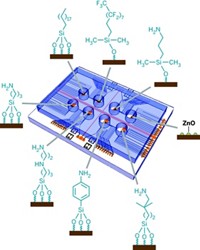Advertisement
Grab your lab coat. Let's get started
Welcome!
Welcome!
Create an account below to get 6 C&EN articles per month, receive newsletters and more - all free.
It seems this is your first time logging in online. Please enter the following information to continue.
As an ACS member you automatically get access to this site. All we need is few more details to create your reading experience.
Not you? Sign in with a different account.
Not you? Sign in with a different account.
ERROR 1
ERROR 1
ERROR 2
ERROR 2
ERROR 2
ERROR 2
ERROR 2
Password and Confirm password must match.
If you have an ACS member number, please enter it here so we can link this account to your membership. (optional)
ERROR 2
ACS values your privacy. By submitting your information, you are gaining access to C&EN and subscribing to our weekly newsletter. We use the information you provide to make your reading experience better, and we will never sell your data to third party members.
Analytical Chemistry
Laser Sensor Detects Tnt Vapor
Device based on a lasing semiconducting polymer has unprecedented sensitivity
by CELIA HENRY
April 18, 2005
| A version of this story appeared in
Volume 83, Issue 16
EXPLOSIVES DETECTION

A fluorescence sensor for explosives developed by researchers at Massachusetts Institute of Technology is 30 times more sensitive than its predecessors. The sensor can easily detect TNT vapor at sub-parts-per-billion levels (Nature 2005, 434, 876).
MIT chemistry professor Timothy M. Swager and coworkers have previously demonstrated sensitive detection based on analytes quenching the fluorescence of semiconducting organic polymers. Now, in collaboration with the group of MIT electrical engineering professor Vladimir Bulovic, they've shown that the sensitivity is amplified at least 30-fold when the organic polymer produces stimulated emission (lasing). The interaction between the analyte and the polymer reduces the lasing, signaling the analyte's presence. The principle should be broadly applicable to any system that can be made to lase, Swager says.
The system tested by the MIT team uses a polymer that lases at a low power threshold. "Instead of hitting it with a sledgehammer, we get to tickle it with a more modest intensity source," Swager says. By exciting the lasing just above that power threshold, sensitivity is improved, and a small dose of the analyte can be enough to stop the lasing completely.
The team used thin films of the polymer to make three types of devices: a waveguide, a diffraction grating, and a coated optical fiber. That any of these could be used to detect TNT demonstrates that the phenomenon doesn't depend on a specific device geometry, Swager says.

Michael J. Sailor, a chemistry professor at the University of California, San Diego, who also develops sensors, says: "In Swager's work, high sensitivity is realized in a few different optical structures that are easy to fabricate, demonstrating the ability to implement such devices in portable, low-power sensing units. The impact of this work should be quite broad in scope."
According to Swager, an unusual architecture improves the polymer's properties as a sensor. The attached alkyl chains run parallel to the conjugated backbone, shrouding and protecting it from degradation. "That's where I dust my knuckles on my shirt and say that's the power of making a darn good polymer," he says.
Like Swager's other polymer sensors, the new sensor has been licensed by Nomadics, a company in Stillwater, Okla., specializing in defense and homeland security applications. Swager is a consultant for the company.
Swager suspects that with additional device engineering, the polymer sensor will be capable of parts-per-quadrillion detection limits. "Devices that are designed solely to be sensors can be much better than what we're showing here," he says.







Join the conversation
Contact the reporter
Submit a Letter to the Editor for publication
Engage with us on Twitter